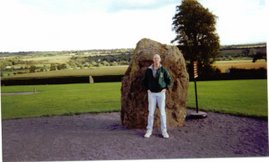Tuesday, December 13, 2005
Mayan Mural Uncovered In Guatemala.
A 2,000-year-old Mayan mural, the oldest such artifact ever found in Central America, was revealed in a recently discovered pyramid in Guatemala. Yahoo News AP wire excerpt:
WASHINGTON - Archaeologist William Saturno said Tuesday he was awe-struck when he uncovered a Maya mural not seen for nearly two millennia. Discovered at the San Bartolo site in Guatemala, the mural covers the west wall of a room attached to a pyramid, Saturno said at a briefing.
In brilliant color, the mural tells the Maya story of creation, he said. It was painted about 100 B.C., but later covered when the room was filled in. "It could have been painted yesterday," Saturno said in a briefing organized by the National Geographic Society, which supported his work and will detail the finding in the January issue of its magazine.
Saturno, of the University of New Hampshire, first reported discovery of the site in 2002 when he stopped to rest in the jungle, taking shelter in an old trench that turned out to be part of the ancient room. Since then the west and north walls have been uncovered. The room's other walls had been demolished and used for fill, he said. The west wall was the centerpiece of the room, Saturno said.
The mural includes four deities, which are variations of the same figure, the son of the corn god. As Saturno explained it: The first deity stands in the water and offers a fish, establishing the watery underworld. The second stands on the ground and sacrifices a deer, establishing the land. The third floats in the air, offering a turkey, establishing the sky. The fourth stands in a field of flowers, the food of gods, establishing paradise.
Another section shows the corn god crowning himself king upon a wooden scaffold, and the final section shows a historic coronation of a Maya king. Some of the writing can be understood, Saturno said, but much of it is so old it is hard to decipher.
Nearby, archaeologists led by Guatemalan Monica Pellecer Alecio found the oldest known Maya royal burial, from around 150 B.C. Excavating beneath a small pyramid, that team found a burial complex that included ceramic vessels and the bones of a man, with a jade plaque, the symbol of Maya royalty, on his chest.
Full Story
It seems silly to use words like "discovered" to describe the process of finding these ancient works. That caveat aside, it is amazing that there are still so many sites in this region that may contain other wonders that have been hidden for so long.
The Mayans, and the other cultures that thrived in this area so long ago were amazingly advanced. They were astronomers who constructed calendars so accurate that they rival those in use today. Many of the engineering feats they accomplished are similar to those in Egypt, which has caused some scholars to speculate that these ancient peoples not only knew of each others existence, but that they had frequent contact.
The late explorer Thor Heyerdahl proved that people could have crossed both the Atlantic Pacific Oceans in simple rafts made of balsa wood and reeds. The similarities between the two cultures cannot be a mere coincidence, and Heyerdahl's journeys point to the very good possibility that a flourishing maritime industry thrived in this distant age, which would explain why many Central American structures contain depictions of human faces of nearly every racial trait--African, Asian, European, Pacific Islander, they are all there, which begs the question of how the artists knew to chisel such faces.
The knowledge gap that exists between what we know about the ancient Americas and ancient Europe, Asia and Africa may now begin to shrink even more, and this news will certainly help to bolster the knowledge we have of the people that transformed the Central American region from Mexico to the Amazon basin so long ago.
Subscribe to:
Post Comments (Atom)

No comments:
Post a Comment